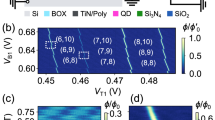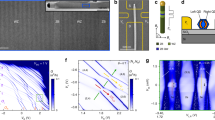Abstract
The control of orbitals and spin states of single electrons is a key ingredient for quantum information processing1,2,3,4,5 and novel detection schemes6,7,8 and is, more generally, of great relevance for spintronics9. Coulomb10 and spin blockade11 in double quantum dots12 enable advanced single-spin operations that would be available even for room-temperature applications with sufficiently small devices13. To date, however, spin operations in double quantum dots have typically been observed at sub-kelvin temperatures, a key reason being that it is very challenging to scale a double quantum dot system while retaining independent field-effect control of individual dots. Here, we show that the quantum-confined Stark effect allows two dots only 5 nm apart to be independently addressed without the requirement for aligned nanometre-sized local gating. We thus demonstrate a scalable method to fully control a double quantum dot device, regardless of its physical size. In the present implementation we present InAs/InP nanowire double quantum dots that display an experimentally detectable spin blockade up to 10 K. We also report and discuss an unexpected re-entrant spin blockade lifting as a function of the magnetic field intensity.
This is a preview of subscription content, access via your institution
Access options
Subscribe to this journal
Receive 12 print issues and online access
$259.00 per year
only $21.58 per issue
Buy this article
- Purchase on Springer Link
- Instant access to full article PDF
Prices may be subject to local taxes which are calculated during checkout





Similar content being viewed by others
References
Loss, D. & DiVincenzo, D. P. Quantum computation with quantum dots. Phys. Rev. A 57, 120–126 (1998).
Petta, J. R. et al. Coherent manipulation of coupled electron spins in semiconductor quantum dots. Science 309, 2180–2184 (2005).
Koppens, F. H. L. et al. Driven coherent oscillations of a single electron spin in a quantum dot. Nature 442, 766–771 (2006).
Hanson, R., Kouwenhoven, L. P., Petta, J. R., Tarucha, S. & Vandersypen, L. M. K. Spins in few-electron quantum dots. Rev. Mod. Phys. 79, 1217–1265 (2007).
Nadj-Perge, S. et al. Spectroscopy of spin–orbit quantum bits in indium antimonide nanowires. Phys. Rev. Lett. 108, 166801 (2012).
Wabnig, J. & Lovett, B. W. A quantum dot single spin meter. New J. Phys. 11, 043031 (2009).
Giavaras, G., Wabnig, J., Lovett, B. W., Jefferson, J. H. & Briggs, G. A. D. Spin detection at elevated temperatures using a driven double quantum dot. Phys. Rev. B 82, 085410 (2010).
Chorley, S. J. et al. Transport spectroscopy of an impurity spin in a carbon nanotube double quantum dot. Phys. Rev. Lett. 106, 206801 (2011).
Zutic, I., Fabian, J. & Das Sarma, S. Spintronics: fundamentals and applications. Rev. Mod. Phys. 76, 323–410 (2004).
Averin, D. V. & Likharev, K. K. Coulomb blockade of single-electron tunneling, and coherent oscillations in small tunnel junctions. J. Low. Temp. Phys. 62, 345–373 (1986).
Ono, K., Austing, D. G., Tokura, Y. & Tarucha, S. Current rectification by pauli exclusion in a weakly coupled double quantum dot system. Science 297, 1313–1317 (2002).
Van der Wiel, W. G. et al. Electron transport through double quantum dots. Rev. Mod. Phys. 75, 1–22 (2003).
Postma, H. W. C., Teepen, T., Yao, Z., Grifoni, M. & Dekker, C. Carbon nanotube single-electron transistors at room temperature. Science 293, 76–79 (2001).
Danon, J. & Nazarov, Yu. V. Pauli spin blockade in the presence of strong spin–orbit coupling. Phys. Rev. B 80, 041301R (2009).
Nadj-Perge, S., Frolov, S. M., Bakkers, E. P. A. M. & Kouwenhoven, L. P. Spin–orbit qubit in a semiconductor nanowire. Nature 468, 1084–1087 (2010).
Pribiag, V. S. et al. Electrical control of single hole spins in nanowire quantum dots. Nature Nanotech. 8, 170–174 (2013).
Nowack, K. C., Koppens, F. H. L., Nazarov, Yu. V. & Vandresypen, L. M. K. Coherent control of a single electron spin with electric fields. Science 318, 1430–1433 (2007).
Steele, G. A. et al. Large spin–orbit coupling in carbon nanotubes. Nature Commun. 4, 1573 (2013).
Steele, G. A., Gotz, G. & Kouwenhoven, L. P. Tunable few-electron double quantum dots and Klein tunneling in ultraclean carbon nanotubes. Nature Nanotech. 4, 363–367 (2009).
Weber, B. et al. Spin blockade and exchange in Coulomb-confined double quantum dots. Nature Nanotech. 91, 430–435 (2013).
Fuhrer, A. et al. Few electron double quantum dots in InAs/InP nanowire heterostructures. Nano Lett. 7, 243–246 (2007).
Bjork, M. T. et al. Few-electron quantum dots in nanowires. Nano Lett. 4, 1621–1625 (2004).
Roddaro, S., Pescaglini, A., Ercolani, D., Sorba, L. & Beltram, F. Manipulation of electron orbitals in hard-wall InAs/InP nanowire quantum dots. Nano Lett. 11, 1695–1699 (2011).
Romeo, L. et al. Electrostatic spin control in InAs/InP nanowire quantum dots. Nano Lett. 12, 4490–4494 (2012).
Pfund, A., Shorubalko, I., Ensslin, K. & Leturcq, R. Suppression of spin relaxation in an InAs nanowire double quantum dot. Phys. Rev. Lett. 99, 036801 (2007).
Golovach, V. N., Khaetskii, A. & Loss, D. Phonon induced decay of the electron spin in quantum dots. Phys. Rev. Lett. 93, 016601 (2004).
Bellucci, D., Rontani, M., Troiani, F., Goldoni, G. & Molinari, E. Competing mechanisms for singlet–triplet transition in artificial molecules. Phys. Rev. B 69, 201308(R) (2004).
Vdovin, E. E. et al. Imaging the electron wave function in self-assembled quantum dots. Science 290, 122–124 (2000).
Panda, J. K. et al. Raman sensitivity to crystal structure in InAs nanowires. Appl. Phys. Lett. 100, 143101 (2012).
Acknowledgements
M.R. acknowledges funding from FP7 Marie Curie ITN INDEX and MIUR-PRIN2012 MEMO. F.R. acknowledges partial financial support of the MIUR through FIRB project RBFR13NEA4 ‘UltraNano’. The authors thank E. Molinari for her supportive work and E. Husanu for STEM imaging.
Author information
Authors and Affiliations
Contributions
S.R. conceived and designed the experiment. D.E. and L.S. grew the nanowires and fabricated the devices. F.R. and D.E. performed the experiment. F.R., S.R., A.B. and M.R. analysed the data. All authors contributed to the writing and discussion of the manuscript.
Corresponding author
Ethics declarations
Competing interests
The authors declare no competing financial interests.
Supplementary information
Supplementary information
Supplementary Information (PDF 1765 kb)
Rights and permissions
About this article
Cite this article
Rossella, F., Bertoni, A., Ercolani, D. et al. Nanoscale spin rectifiers controlled by the Stark effect. Nature Nanotech 9, 997–1001 (2014). https://doi.org/10.1038/nnano.2014.251
Received:
Accepted:
Published:
Issue Date:
DOI: https://doi.org/10.1038/nnano.2014.251
This article is cited by
-
Electrical probing of carrier separation in InAs/InP/GaAsSb core-dualshell nanowires
Nano Research (2020)
-
Microwave-Assisted Tunneling in Hard-Wall InAs/InP Nanowire Quantum Dots
Scientific Reports (2019)
-
Spectroscopy of the superconducting proximity effect in nanowires using integrated quantum dots
Communications Physics (2019)
-
Suspended InAs Nanowire-Based Devices for Thermal Conductivity Measurement Using the 3ω Method
Journal of Materials Engineering and Performance (2018)
-
InAs nanowire superconducting tunnel junctions: Quasiparticle spectroscopy, thermometry, and nanorefrigeration
Nano Research (2017)



